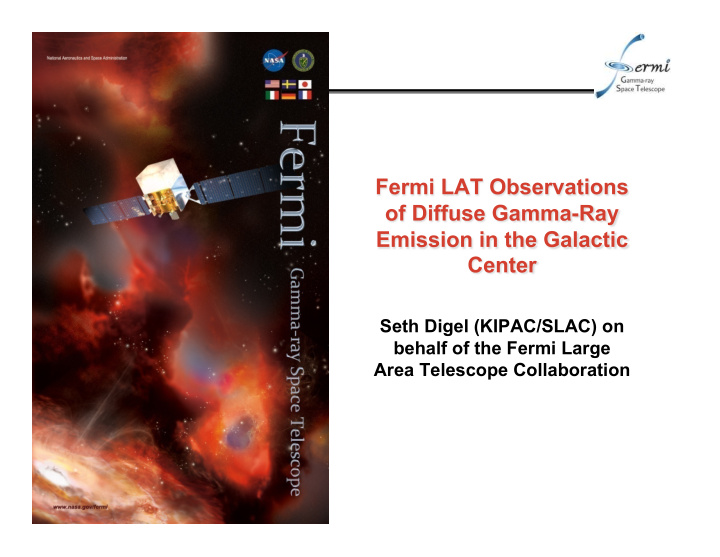



Seth Digel (KIPAC/SLAC) on behalf of the Fermi Large Area Telescope Collaboration
• LAT and LAT observations of the Galactic Center region • Origin of diffuse gamma-ray emission • Modeling the diffuse gamma-ray emission – What’s wrong with doing it in the GC • Approaches to updating gas and cosmic-ray distributions – refining the model • Current status and next steps 2 2009 Fermi Symposium
• Exposure, angular resolution, stability of response • Never as much as you’d want, but a huge advance LAT >1 GeV +3° LAT Observation of the GC region COS-B >300 MeV Stacy, Dame, & Thaddeus (1987) –3° 5° 355° 12-month data set, Diffuse class, Front only smoothed with σ = 0.1° BSL source location circles overlaid 3 2009 Fermi Symposium
• Production mechanisms are well understood ‒ π 0 decay – secondaries from CR proton-nucleon π 0 collisions p – Bremsstrahlung – scattering of CR electrons by p protons/nuclei – Inverse Compton scattering of low-energy photons by CR electrons e – The nuclei that matter are in interstellar gas – not e stars – The photons are starlight, re-radiated starlight, and CMB Z • Why model the diffuse emission? 1) because we have to; e e 2) to learn about the interstellar medium and cosmic rays e e 4 2009 Fermi Symposium
• Radiative transfer is simple – the Milky Way is transparent to LAT gamma rays; corollary: GC diffuse emission comes from 25+ kpc path length to and through the Galactic center Launhardt et al. (2002) Schematic but it has the general features right • This region of the sky is perhaps the most difficult to model accurately, even if we understood the distribution of CR sources and cosmic-ray propagation (not that we don’t, GALPROP fans!) – Of course, GIGO applies – gas distributions, ISRF, cosmic- ray sources & propagation 5 2009 Fermi Symposium
• Challenges: conditions and kinematics CO distribution in velocity and longitude H I in absorption against Sgr A* T R (K) Velocity (km s -1 ) H I in self absorption T R (K) Longitude (deg) CfA CO (Dame et al.) Velocity (km s -1 ) Leiden-Argentine-Bonn H I (Kalberla et al.) • We interpolate ‘rings’ across the GC (| l | < 12°) and use a Launhardt-like NB component in the innermost ring 6 2009 Fermi Symposium
• H.E.S.S. survey of the Galactic plane revealed a TeV diffuse component (after source subtraction), photon spectral index ~2.3, considerably harder than 2.7 for Galactic CRs H.E.S.S. Aharonian et al. (2006) 7 2009 Fermi Symposium
• Refining the diffuse emission model is done in comparison with LAT data, which means it must be iterative with low- latitude point source detection and fitting • We have 2 approaches within the LAT collaboration for large- scale modeling of diffuse emission: GALPROP-based and a kind of hybrid, fitting linear combinations of templates for gas and IC-related emission – Spatially, the methods are similar – Spectrally, the hybrid approach (with more d.o.f.) allows closer matching to the LAT data • The hybrid approach is the basis for gll_iem_v02.fit*, the first public release * http://fermi.gsfc.nasa.gov/ssc/data/access/lat/BackgroundModels.html 8 2009 Fermi Symposium
• The all-sky Galactic diffuse emission model released by the LAT team (red curve) somewhat under-predicts the sky intensity in the GC region • Similar deviations are present in a GALPROP model calculation (blue) for the same region; • Models are clearly in the right ballpark, although clearly deviations are greater than the systematic uncertainty • N.B.: No point sources are included 9 2009 Fermi Symposium
• The diffuse gamma-ray intensity in the GC region is intense not dominated by the GC region • Systematic uncertainties in the GC contribution remain large 10 2009 Fermi Symposium
• The diffuse gamma-ray intensity in the GC region is intense & not dominated by the GC region • Systematic uncertainties in the GC contribution remain large, interstellar radiation and gas Inner 1 kpc Components of this GALPROP model π 0 Brem IC Iso 11 2009 Fermi Symposium
• Focus on the GC CS (1-0) Tsuboi et al. region for structure (1999) NRO 45-m at low longitudes • Alternative tracers C 18 O (1-0) Dahmen for molecular gas: et al. (1997) Southern 1.2-m higher critical density or optically thin(ner) than CO LAT >1 GeV • Launhardt et al. (2002) & Ferriere, Gillard, & Jean (2007) studied gas in the inner Milky Way, but with parametrized distributions 12 2009 Fermi Symposium
• Understanding the diffuse emission toward the Galactic Center quantitatively (spatially and spectrally) relates to understanding the state of the gas, the interstellar radiation field, cosmic-ray sources, and propagation • Standard all-sky models are only ~ok in the GC region • Refinement goal: understanding of point sources + diffuse emission together 13 2009 Fermi Symposium
Recommend
More recommend